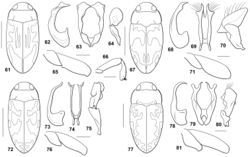Bidessodes jucundus
| Notice: | This page is derived from the original publication listed below, whose author(s) should always be credited. Further contributors may edit and improve the content of this page and, consequently, need to be credited as well (see page history). Any assessment of factual correctness requires a careful review of the original article as well as of subsequent contributions.
If you are uncertain whether your planned contribution is correct or not, we suggest that you use the associated discussion page instead of editing the page directly. This page should be cited as follows (rationale):
Citation formats to copy and paste
BibTeX: @article{Miller2017ZooKeys, RIS/ Endnote: TY - JOUR Wikipedia/ Citizendium: <ref name="Miller2017ZooKeys">{{Citation See also the citation download page at the journal. |
Ordo: ORDO
Familia: FAMILIA
Genus: Bidessodes
Name
Bidessodes jucundus Young, 1986 – Wikispecies link – Pensoft Profile
- Bidessodes (Bidessodes) jucundus Young, 1986: 209; Biström, 1988: 7; Nilsson, 2016: 98.
Diagnosis
This species does not have a carinate prosternum in either male or female. The prosternal process is longitudinally slightly impressed, the lateral margins are convergent to the pointed apex. The male mesotibia is basally abruptly curved (Fig. 66). The male metafemur is moderately broad and has a distinct denticle along the ventral margin apically and another near the apex of the trochanter (Fig. 65). Unlike other species, the lateral pronotal margins are not strongly curved (Fig. 61). The male abdominal ventrite VI is unmodified. The male median lobe is deeply bifurcate with each branch narrow and apically broadly expanded and spatulate in ventral aspect (Fig. 63). In lateral aspect the median lobe is narrow and abruptly and evenly curved (Fig. 62). The basal segment of the lateral lobe is very slender and small, and the apical segment is large and broadly round (Fig. 64).
Distribution
The species is known from Brazil and Bolivia (Fig. 103). Young (1986)[1] mentioned a potential specimen from Panama, but this seems unlikely.
Taxon Treatment
- Miller, K; 2017: A review of the Neotropical genus Bidessodes Régimbart, 1895 including description of four new species (Coleoptera, Adephaga, Dytiscidae, Hydroporinae, Bidessini) ZooKeys, (658): 9-38. doi
Images
|
Other References
- ↑ Young F (1986) Review of the predaceous water beetles of the genus Bidessodes Régimbart (Coleoptera: Dytiscidae). Entomologica Basiliensia 11: 203–220.

